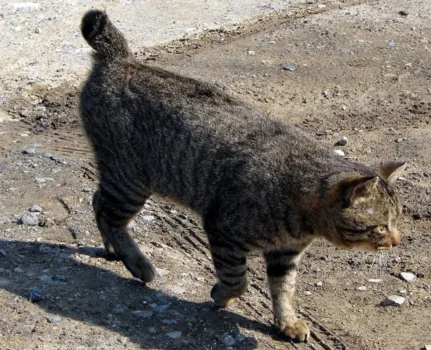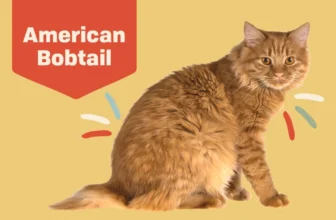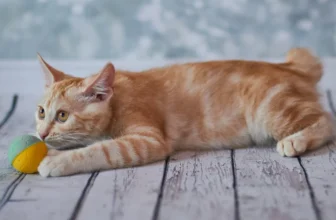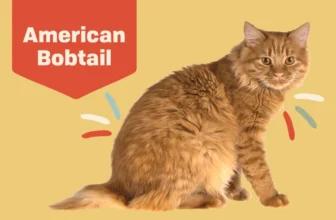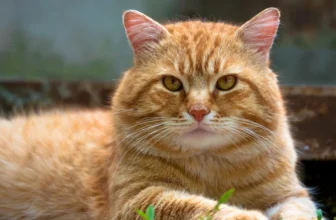Caring for a pet can be a big responsibility, but when it comes to the American Bobtail breed, the care required for their unique tail must be taken seriously. Understanding the intricacies of their tail can help prevent potential health problems and improve their overall well-being. In this guide, we’ll take a closer look at what makes the American Bobtail’s tail unique, why tail care is important, and how you can properly care for it step-by-step. So, let’s dive into the world of the American Bobtail and become tail care experts!
Understanding the American Bobtail’s tail
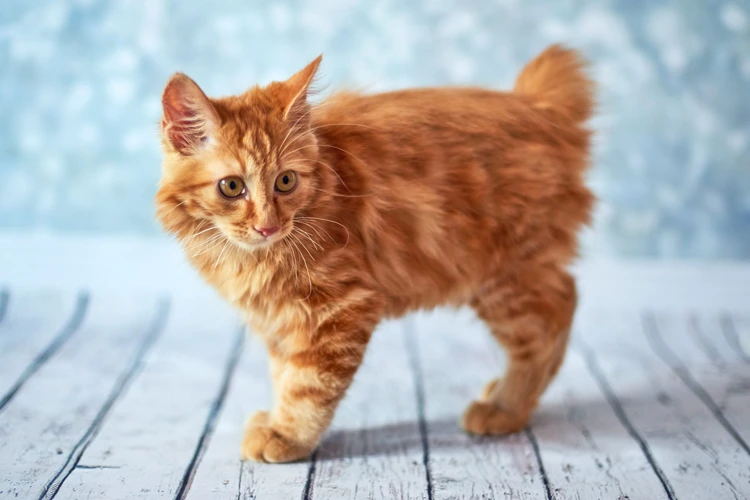
The American Bobtail is a unique breed of cat, known for its distinctive tail. Understanding the characteristics of an American Bobtail’s tail is essential to provide proper care for your furry friend. From the length and shape to the muscles and size, every feature of their tail has a significant role to play in their overall health and agility. In this section, we’ll delve into the details of the American Bobtail’s tail, exploring what makes it so special and its importance to the breed. If you want to learn more about the different tail lengths, shapes, and meanings in Bobtail cats, click here.
What makes an American Bobtail’s tail unique
The American Bobtail’s tail is one of the breed’s most unique features. This short and sturdy tail can range from 1 to 4 inches in length and has a thick base, tapering off to a rounded tip. What sets the American Bobtail’s tail apart is not only its length but also its flexibility and range of motion.
The tail is comprised of several vertebrae, adaptations to the bobtail gene that give the tail its distinctive shape and functionality. This gene affects not only the length of the tail but also the muscles and nerves within it, giving the tail its exceptional strength, balance, and agility. These specialized muscles and nerves allow the tail to be used like a “third limb” and provide the cat with added stability and control.
Another unique aspect of the American Bobtail’s tail is its balance. The short length of the tail is perfectly proportioned to the cat’s body, allowing for easy movement and balance. This is particularly important for the breed since the cat is known for its high activity level and love of climbing.
In addition to its practical uses, the American Bobtail’s tail is also visually striking. Its thick fur and rounded shape make it a distinctive and eye-catching feature of the breed.
The American Bobtail’s tail is a fascinating and essential part of the cat’s anatomy, providing both practical function and aesthetic appeal. Understanding the unique qualities of the American Bobtail’s tail is key to properly caring for this incredible breed. For more information on the American Bobtail’s tail evolution, please refer here.
Why tail care is important
A healthy tail is an essential part of an American Bobtail’s anatomy. This breed is known for its unique bobbed tail, which is relatively short and can range from two to four inches long. Despite their tail being shorter than other feline breeds, it plays a vital role in their mobility and balance. That’s why taking proper care of it is so important for their well-being. Below are some factors that highlight the importance of tail care:
- Prevention of injuries: The American Bobtail’s tail length and muscles contribute to its agility, allowing it to make quick and sudden movements. However, this also puts them at greater risk of tail injuries. Caring for their tail properly can help prevent any damages that could lead to long-term problems.
- Comfort and hygiene: Conducting regular maintenance on your American Bobtail’s tail will make them feel much more comfortable. When their fur is well-groomed, it reduces the chances of matting and tangles. Also, a clean tail decreases the risk of infections and other conditions that can be uncomfortable for your pet.
- Tail care aids in monitoring health: One of the best ways to monitor your American Bobtail’s health is by observing changes in their tail. Any signs of inflammation or injury can be indicative of something more serious. Regular tail care routines can help you keep an eye on your pet’s health.
- Preserves breed identity: The American Bobtail’s tail is an essential element of its breed identity. Proper tail care helps maintain the unique bobbed tail look which sets them apart from other feline breeds. It is important to keep their tail in good shape to preserve this breed’s identity and characteristics.
Caring for an American Bobtail’s unique tail is an important responsibility for every owner. Neglecting proper tail care can lead to various problems that can adversely impact their health and well-being. If you want to learn more about the American Bobtail’s tail and related topics, check out our article on tail length in American Bobtails, tail size and balance in American Bobtails, tail muscles and bobtail agility, and the bobtail gene in American Bobtails.
Tail Care 101
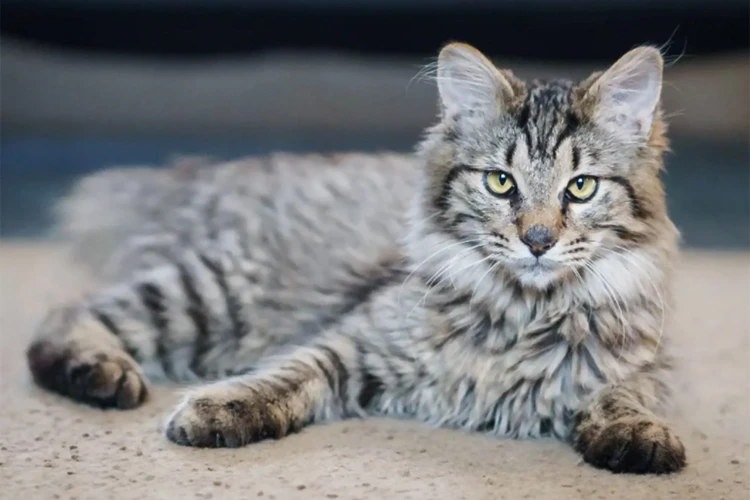
When it comes to caring for your American Bobtail’s unique tail, there are some basic steps you should take to ensure its health and beauty. From regular brushing and cleaning to handling with care, these tips will help keep your cat’s tail in top shape. So, let’s dive into the world of tail care and discover the essential practices that will keep your American Bobtail’s tail looking and feeling its best.
Regular brushing and combing
Regular brushing and combing of an American Bobtail’s unique tail is essential for maintaining its health and appearance. Here are some tips for effective tail brushing and combing:
- Choose the right tools: Use a fine-toothed comb and a soft-bristle brush to gently remove any tangles and mats.
- Start slow: Begin by slowly and gently brushing the tail from the base to the tip, being careful not to pull on any snarls or knots.
- Be patient: It may take a while to remove all the tangles and mats, so take your time and be patient with your American Bobtail.
- Brush regularly: Regular brushing, at least once a week, will help to prevent tangles and mats from forming in the first place, making maintenance much easier in the long run.
- Check for any abnormalities: While you are brushing and combing, be sure to check for any skin irritations, bumps, or lumps, as these could be signs of a potential health problem.
By following these simple tips for regular tail brushing and combing, you can help to prevent matting and tangles, and keep your American Bobtail’s tail looking healthy and beautiful.
Cleaning the tail and surrounding area
Keeping your American Bobtail’s tail and surrounding area clean is an essential part of their overall hygiene. This not only helps keep your cat looking and smelling great, but it also prevents infections and other potential health issues. Here’s what you need to know about cleaning your cat’s tail and surrounding area.
Step 1: Gather Supplies
Before you begin, gather all the necessary supplies. You’ll need a mild cat shampoo, a bowl of lukewarm water, several clean towels, and a comb or brush suited for your cat’s coat type.
Step 2: Wet the Tail
Dip your cat’s tail into the bowl of lukewarm water, taking care not to get water inside their anus, as this can cause discomfort.
Step 3: Apply Shampoo
Squeeze a small amount of cat shampoo onto your hands and massage it gently into the fur on the tail and surrounding area. Avoid getting shampoo inside the anus or on the genitals.
Step 4: Rinse Thoroughly
Rinse the shampoo from the tail and surrounding area thoroughly with lukewarm water, taking care not to leave any soap residue.
Step 5: Dry the Tail
Gently pat the tail dry using a clean towel, taking care not to rub the fur too hard or pull on it.
Step 6: Comb or Brush the Tail
Once the tail is dry, use a comb or brush suited for your cat’s coat type to remove any tangles or mats. Take care not to pull on the fur or cause any discomfort.
Note: If your American Bobtail has long hair, consider trimming the fur around the anus to prevent fecal matter from sticking to the fur.
Remember, keeping your American Bobtail’s tail and surrounding area clean is an essential part of their overall care. If you notice any unusual swelling, redness, or discharge, consult with your veterinarian right away, as this may be a sign of infection or other potential health issues.
Trimming the fur around the tail
One important aspect of caring for an American Bobtail’s unique tail is ensuring that the fur around it is properly trimmed. This can help prevent the fur from becoming matted or dirty, and also allows for better mobility of the tail.
When to trim: It’s generally recommended to trim the fur around the tail every few weeks, depending on how quickly your cat’s fur grows. You may also want to trim the fur if you notice any matting or tangling.
Tools needed: To trim the fur, you’ll need a small pair of scissors, such as rounded-tip scissors designed for pet grooming. It’s also helpful to have a comb on hand to help separate the fur and make trimming easier.
Trimming technique: Begin by combing through the fur around the tail to ensure that it’s free of any tangles or mats. Then, using the scissors, carefully trim the excess fur around the tail. Be sure to only trim a small amount at a time to avoid accidentally cutting your cat’s skin. It’s also important to be very gentle and avoid pulling or tugging on the tail, as this can be painful for your cat.
Post-trim care: After trimming the fur, comb through it again to ensure that there are no stray hairs or tangles. You can also use a damp cloth to wipe down the tail and surrounding area to remove any loose fur or debris.
By incorporating regular fur trimming into your American Bobtail’s tail care routine, you can help ensure that their tail stays healthy and clean. Remember to always be gentle and cautious when trimming the fur around the tail, and if you’re unsure of how to do it properly, consult with a veterinarian or professional pet groomer.
Handling the tail with care
It’s important to handle an American Bobtail’s unique tail with great care to avoid causing any damage or discomfort. Here are some tips to help you handle your cat’s tail in the most gentle and effective way possible:
- Approach with caution: When approaching your cat, always approach their tail area cautiously and gently. This will give them time to adjust and feel comfortable before you start handling their tail.
- Start at the base: Gently start handling the tail at its base, closest to the body. Slowly work your way down the tail, keeping your movements calm and smooth to avoid startling your cat.
- Never pull or tug: Avoid pulling or tugging on your cat’s tail to prevent any potential injury or discomfort. Remember, the tail is an extension of your cat’s spine and can be easily damaged.
- Observe your cat’s body language: Pay attention to your cat’s body language as you handle their tail – if they start showing signs of discomfort or agitation, stop immediately.
- Use treats and positive reinforcement: To help your cat associate tail handling with positive experiences, offer them treats, praise, and gentle petting while you handle their tail.
- Be gentle: Always be gentle and patient when handling your cat’s tail. Remember, this is an important and sensitive part of their body that needs to be handled with care.
By following these tips, you can ensure that you are handling your American Bobtail’s unique tail with the utmost care and respect. Not only will this keep your cat happy and comfortable, but it will also strengthen the bond between you and your furry friend.
Potential tail problems

While it’s important to know how to properly care for an American Bobtail’s unique tail, unfortunately, there are potential problems that can arise even with the best care. It’s essential to be aware of these potential issues so that you can spot them early and address them promptly. Here are some potential tail problems to look out for when caring for your American Bobtail.
Matting and tangles
Matting and tangles are common problems that can be experienced with an American Bobtail’s distinctive tail. These issues can be uncomfortable for your feline friend, and if left untreated, can lead to further health complications. It is important to take preventative measures to avoid matting and tangles from developing on your American Bobtail’s tail.
Causes of Matting and Tangles
Matting and tangles can be caused by a variety of factors, including poor grooming habits, lack of attention, and an unhealthy diet. Dirt and debris can accumulate in the fur of the tail, causing it to become knotted and tangled. Long-haired American Bobtail cats are especially susceptible to this problem, but all cats can experience matting and tangles if their tail is not properly cared for.
Preventative Measures
Regular grooming is essential in preventing matting and tangles from developing on your American Bobtail’s tail. Daily brushing and combing of the fur will help to remove any dirt, debris, or fur knots, keeping it clean and healthy. Long-haired American Bobtail cats may require more frequent brushing to avoid matting and tangles.
Treatment Options
If you notice matting or tangling on your American Bobtail’s tail, it is important to address the issue quickly to minimize discomfort and prevent further health complications. One treatment option is to use a detangling spray, which will help to loosen the knots and make it easier to comb through the fur. Another option is to carefully cut away the matting with scissors, being mindful not to cut the cat’s skin.
When to Seek Veterinary Care
In severe cases of matting and tangles, it may be necessary to seek veterinary care. A veterinarian can sedate the cat and carefully remove the tangled fur to prevent injury to the cat’s skin. Additionally, if your cat is experiencing matting and tangles frequently, it may be a sign of an underlying health condition. A veterinarian can perform a thorough examination to determine if there are any underlying health issues contributing to the problem.
The key to preventing matting and tangles on an American Bobtail’s tail is regular grooming and attention. By maintaining good grooming habits and addressing any matting or tangling issues quickly, you can ensure your cat’s tail stays healthy and happy.
Wounds and injuries
When it comes to wounds and injuries to an American Bobtail’s tail, it’s important to act quickly to prevent further damage and avoid infection. Any wound, no matter how small, should be taken seriously.
Causes of Tail Injuries: American Bobtails are known for their active lifestyle and playful nature, which can sometimes lead to accidents that result in tail injuries. Jumping from high places or playing too rough with other pets can cause damage to their tail.
Signs of a Tail Injury: Watch out for signs of injury, such as bleeding, swelling, or even changes in the tail’s movement or position. If you notice your American Bobtail licking or biting at their tail excessively, or if your cat seems to be in pain, take a closer look for any signs of injury.
First Aid for Tail Injuries: If your American Bobtail experiences a tail injury, the first thing to do is to gently clean the area with warm water and mild soap. Apply an antiseptic ointment to the wound to help prevent infection, and then apply a bandage or wrap loosely around the tail to keep it clean and protected.
When to Call the Vet: If the wound is deep, the bleeding won’t stop, or if there are signs of nerve damage or loss of mobility in the tail, it’s important to call your veterinarian right away. A vet can assess the extent of the injury and prescribe any necessary medication to help your American Bobtail heal.
Preventing Tail Injuries: As always, prevention is key. Providing plenty of toys and scratching posts for your American Bobtail can help redirect their playful energy away from their tail. Additionally, supervising playtime with other pets and keeping your Bobtail away from high places can reduce the risk of tail injuries.
| Causes of Tail Injuries | Signs of a Tail Injury | First Aid for Tail Injuries | When to Call the Vet | Preventing Tail Injuries |
|---|---|---|---|---|
| Active lifestyle and playful nature | Bleeding, swelling, changes in tail movement or position, excessive licking or biting of tail, pain | Clean the area with warm water and mild soap, apply antiseptic ointment, lightly bandage or wrap tail to keep it clean and protected | Deep wounds, uncontrolled bleeding, nerve damage or loss of tail mobility | Provide toys and scratching posts, supervise playtime with other pets, keep away from high places |
Ringworm and other infections
Ringworm and other infections are among the most common ailments that can affect an American Bobtail’s tail. These infections can cause discomfort, itching, and other symptoms that can make your cat’s life miserable. It’s important to identify the symptoms of these infections and take steps to treat them as soon as possible to prevent their spread. Here are some of the signs and symptoms to look out for:
| Signs and Symptoms | Treatment |
|---|---|
| Bald patches along the tail or surrounding areas | If caused by ringworm, anti-fungal medication can help clear up the infection. Other bacterial infections may require antibiotics. |
| Redness, swelling or discharge | If caused by an infection, a topical or oral antibiotic will likely be prescribed by a veterinarian. |
| Itching or scratching at the tail | Anti-itch medication, hypoallergenic shampoo, and/or a change in diet may be necessary. |
| Foul odor from the tail | Decontamination and cleaning of the infected area with prescribed medicated shampoos, topical antibiotics or antifungal medication. |
Ringworm is a fungal infection that is easily spread between pets and humans through direct contact. It is essential to isolate any infected cat to prevent the spread of the disease to other pets or family members, and to regularly disinfect bedding, furniture, and carpets. Other infections that can affect the tail and surrounding areas include bacterial infections, parasites, and allergies. A veterinarian can assist in the proper diagnosis and treatment of these conditions.
Always pay attention to any changes in your American Bobtail’s tail, as early detection of infections can help prevent more severe outcomes. Regular grooming and hygiene maintenance can help keep your cat’s tail healthy and reduce the risk of infections.
Nerve damage and loss of mobility
Our furry friends, the American Bobtails, have a unique tail that requires special care to keep it healthy and in pristine condition. However, even with the best of care, there is a possibility that your cat may experience nerve damage or loss of mobility in their tail.
Symptoms of nerve damage or loss of mobility in the tail:
| Symptom | Description |
| Flaccid tail | The tail hangs limply and may drag on the ground. |
| Lack of response to stimuli | Your cat may no longer react to touch or sensation in their tail. |
| Incontinence | Your cat may have difficulty controlling their bowel and bladder movements. |
| Pain | Your cat may experience pain or discomfort in their tail or surrounding area. |
Causes of nerve damage or loss of mobility in the tail:
There are several potential causes of nerve damage or loss of mobility in the tail, including:
– Trauma to the tail or spine
– Neurological disorders
– Infections or parasites
– Tumors or growths
Treatment for nerve damage or loss of mobility in the tail:
Treatment for nerve damage or loss of mobility in the tail depends on the underlying cause of the condition. Your veterinarian may recommend one or more of the following treatments:
– Pain management medication
– Anti-inflammatory medication
– Antibiotics for infections or parasites
– Surgery to remove tumors or growths
In some cases, nerve damage or loss of mobility in the tail may be irreversible. However, with proper care and attention from a qualified veterinarian, your furry friend may still be able to lead a happy and comfortable life.
Advanced tail care
As much as regular tail care is important for your American Bobtail, sometimes it may not be enough to ensure optimal tail health. For example, if your cat has any underlying medical conditions or is predisposed to certain ailments, advanced tail care may be necessary. In this section, we will explore some advanced techniques and tools to help maintain your cat’s tail health, including the use of supplements, special grooming tools, and consulting with a veterinarian for expert advice.
Supplements for tail health
As with any other part of a cat’s body, a healthy diet is essential for maintaining a healthy tail. However, some cat owners may want to supplement their American Bobtail’s diet with additional nutrients that can promote tail health. Here are some supplements that can be beneficial:
- Fatty acid supplements: Omega-3 and omega-6 fatty acids are essential for maintaining healthy skin and fur, which in turn contribute to a healthy tail. These supplements can also help reduce inflammation and itching that can lead to excessive scratching of the tail.
- Biotin supplements: Biotin is a B-vitamin that is essential for maintaining healthy skin and coat. It can also help prevent dry skin and hair loss, which may affect the tail.
- Vitamin E supplements: Vitamin E is an antioxidant that can help protect cells from damage. It can also help improve circulation and promote healing, which can be beneficial for any wounds or injuries that affect the tail.
It’s important to note that before starting any supplement regimen, you should consult with a veterinarian. They can help determine the appropriate dosage for your cat based on their age, weight, and overall health. Additionally, supplements should not be used as a replacement for a balanced and nutritious diet.
In addition to supplements, there are also some grooming techniques that can help promote tail health. Regular brushing and combing can help distribute natural oils throughout the tail, preventing dryness and promoting a shiny appearance. Trimming any excess fur around the tail can also prevent matting and tangles that can lead to discomfort and irritation. These practices, combined with a healthy diet and potential supplement regimen, can help keep your American Bobtail’s tail in tip-top shape.
Special grooming tools and techniques
Grooming an American Bobtail’s unique tail requires special tools and techniques. Here are some of the grooming tools and techniques that will help keep your cat’s tail healthy and beautiful:
- Grooming gloves: These gloves are designed to help remove loose fur and tangles from your American Bobtail’s tail. They are gentle and can be used to massage your cat’s tail, promoting healthy blood flow.
- Slicker brush: Using a slicker brush can help to remove tangles and matting from your cat’s tail. It gently detangles the fur without pulling or causing pain to your cat.
- Flea comb: While fleas aren’t usually a problem with American Bobtails, a flea comb can still be useful for removing debris and dirt from your cat’s tail.
- Wide-tooth comb: A wide-tooth comb is best for American Bobtails with longer hair. It helps to remove tangles and prevent matting.
When grooming an American Bobtail’s tail, it’s important to go slow and be gentle. You don’t want to hurt your cat or cause any unnecessary stress. Start by using your hands to gently massage and stroke your cat’s tail. Then move on to using the grooming tools to remove any tangles, matting, or debris.
Always avoid using scissors or clippers near your cat’s tail, as this can be dangerous and lead to injury. Instead, use a comb or grooming glove to detangle the hair.
Remember to always reward your cat with treats and praise throughout the grooming process. This will help your cat associate grooming with positive experiences and make future grooming sessions easier.
Consulting with a veterinarian
It’s always a good idea to consult with a veterinarian when it comes to your American Bobtail’s tail care. A professional will be able to provide you with expert advice on any issues or concerns you may have. Here are some steps to follow when consulting with a veterinarian:
- Research potential veterinarians in your area to find one who specializes in feline care.
- Book an appointment with the chosen veterinarian, bringing along any information about your American Bobtail’s medical history and any concerns you have specifically about their tail.
- Ask questions about best practices for tail care, including grooming techniques and product recommendations. Your veterinarian may also suggest supplements or specialized food that could improve your cat’s overall tail health.
- Address any particular concerns you have. If you notice any unusual changes in your American Bobtail’s tail, such as hair loss, mobility issues, or strange bumps, make sure to bring these up with your veterinarian. They may recommend additional tests or procedures to properly diagnose and treat the problem.
- Follow up with your veterinarian’s recommended treatment plan and schedule any necessary follow-up appointments to monitor your cat’s tail health.
Remember, your veterinarian is there to help you ensure that your American Bobtail’s tail stays healthy and well-cared for. Don’t hesitate to seek their advice and expertise whenever you have any questions or concerns.
Conclusion
In conclusion, properly caring for an American Bobtail’s unique tail is essential for their overall health and well-being. The tail serves many important functions, from balance and communication to body temperature regulation. Neglecting tail care can lead to a number of potential problems, including matting, tangles, injuries, infections, and impaired mobility.
Regular brushing, cleaning, and trimming are important aspects of basic tail care. However, if you want to take tail care to the next level, there are advanced techniques and tools you can explore. Consulting with a veterinarian can also be helpful to address any specific concerns or questions you may have about your American Bobtail’s tail.
Remember to always handle your cat’s tail with care and gentleness, as it is a sensitive and delicate part of their body. By following the tips outlined in this article, you can ensure that your American Bobtail’s tail remains healthy, happy, and beautiful for years to come.
Frequently Asked Questions
1. How often should I brush my American Bobtail’s tail?
Regular brushing is recommended, ideally on a daily basis. This helps prevent matting and tangles, which can be painful for your pet.
2. Can I use human grooming tools on my American Bobtail’s tail?
No, it is not recommended. Use specially designed pet grooming tools to avoid injuring the skin or damaging the fur.
3. What should I do if my American Bobtail’s tail is injured?
If your pet has an injured tail, seek veterinary attention immediately. Depending on the severity of the injury, it may require medical treatment.
4. Are there any specific supplements for tail health?
Yes, there are a variety of supplements that can promote healthy skin and fur. Consult with your veterinarian for recommendations.
5. Can I wash my American Bobtail’s tail with human shampoo?
No, using human shampoo can dry out your pet’s skin and cause irritation. Use pet shampoo specifically designed for cats.
6. How can I prevent ringworm on my American Bobtail’s tail?
Ringworm is highly contagious, so it’s important to keep your pet away from infected animals. Regular grooming and keeping your home clean can also help prevent the spread of infection.
7. Should I bandage my American Bobtail’s tail if it’s injured?
No, bandaging the tail can actually prevent proper healing and cause further injury. Consult with your veterinarian for proper treatment.
8. Is it normal for my American Bobtail to have a kink in their tail?
Yes, some American Bobtails may have a natural kink in their tail. This is a normal and natural characteristic of the breed.
9. Can I use coconut oil to condition my American Bobtail’s tail?
Yes, coconut oil can be a great natural conditioner for your pet’s fur. Just be sure to use it sparingly, as too much can make the fur greasy.
10. Can I prevent nerve damage in my American Bobtail’s tail?
While there is no guaranteed way to prevent nerve damage, handling your pet’s tail with care and seeking medical attention for any injuries can help reduce the risk.

